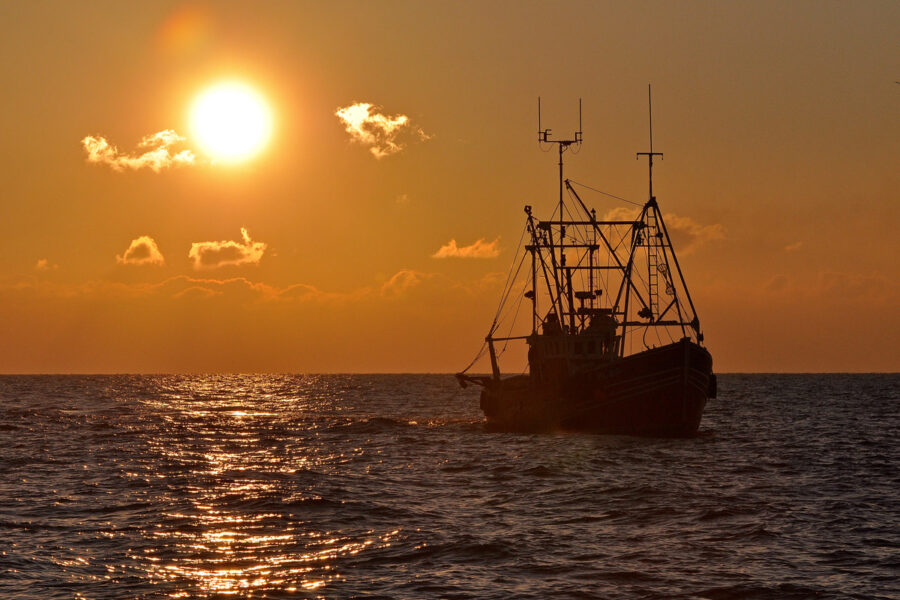With the 2020 king scallop season in the Isle of Man Territorial Sea having opened on 1 November, David Linkie looks back nine years to a day with Peel skipper Darren Purves on the under-10m scalloper Manx Ranger PL 40, fishing off the west coast of the Isle of Man
The saying ‘everything comes to those who wait’ is certainly apt in relation to my experiencing the start of the Isle of Man king scallop fishery. For the previous four years, a combination of force 10 forecasts for the opening days of the fishery, the delivery of new boats, fisheries conferences and commitments to other FN features made it seem in danger of becoming mission improbable, if not impossible.
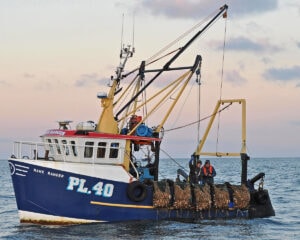
01 Manx Ranger lifting the port dredges.
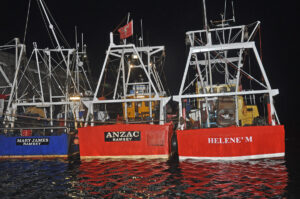
02 Ready for the off – the Ramsey under-10m boats Mary James, Anzac and Helene M alongside Peel breakwater, shortly before departing for the Bradda Head grounds.”
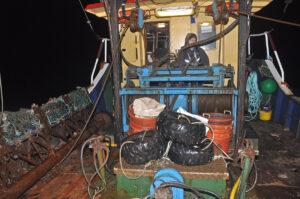
03 Darren Purves preparing to drop the scallop gear for the first tow.
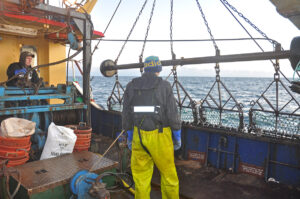
04 Taking the starboard dredges aboard after the first haul of the morning.
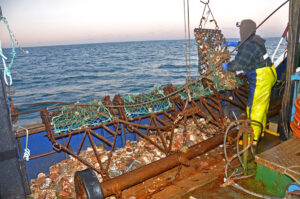
05 Crewman Neil Quayle tips the dredges…
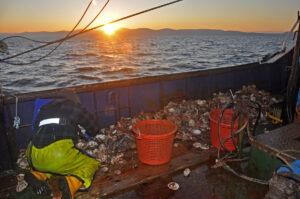
06 … before starting to pick scallops off the deck as the sun rises over the Manx hills.
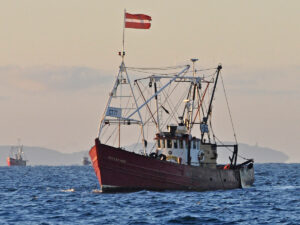
07 Spaven Mor precedes Coral Strand II and June Rose north on a crisp November morning.
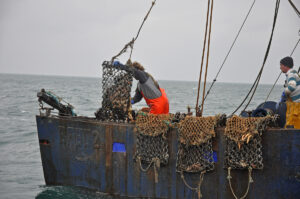
08 Tipping the dredges on Ian Morrison’s June Rose.
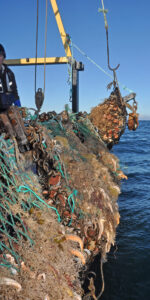
09 Starting to tip the port side dredges after the third haul…
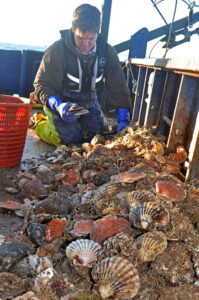
10 … before skipper Darren Purves picks selected scallops off the deck…
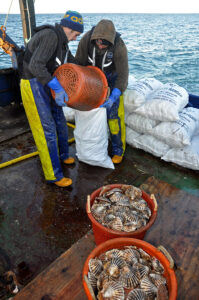
11 … and fills the first of three baskets.

12 Queensberry towing in late afternoon sunlight.
This seemed to be the case again towards the end of October 2011, when although XC Weather was indicating a settled period for the first full week of the scallop fishery, the Western Waters Closure, which meant that only under-15m scallopers would be fishing, looked likely to mean yet another postponement, as there seemed little point in going at a time when some of the regular participants in the Manx fishery were unable to fish. Fortunately, news of the reopening on Friday, 4 November was received when there was still space available on the Sunday ferry sailing from Birkenhead to Douglas, and it was possible to rebook the B&B.
On arriving at Peel breakwater shortly before 5am the following morning – after scraping ice off the windscreen – it was a hub of activity, as some 25 crews parked up before throwing off the ropes. Engines coughed into life along the quay, where boats were berthed four and five abreast.
After skipper Darren Purves had put the Doosan engine into gear, Manx Ranger took her place in a succession of scallop boats that rounded Peel breakwater before either setting a course for the Targets – named after a former naval firing range north of Peel – or heading southwest for the grounds off Bradda Head and the Chicken Rock lighthouse.
The reason for all the fleet leaving harbour together was – and still is – the night-time curfew on scallop fishing, which is a well-established part of the scallop fishery management measures drawn up by the Isle of Man government’s Department of Environment, Food and Agriculture.
Within 0-3 miles, the closure extended from 6pm-6am, and from three to 12 miles, from 8pm-6am. One hour was added to the previous start and finish times of 5am and 9pm from 2010 in order to further reduce fishing effort. Being equipped with a satellite tracking device is a mandatory requirement for any vessel applying for, and being issued with, an annual licence to fish scallops in Isle of Man waters.
Having opted for the Targets, from where Manx Ranger had found steady fishing the previous two days, just over an hour later skipper Darren Purves pulled back the handle and clutched in the hydraulics. He and crewman Neil Quayle then slipped on their flotation jackets and MOB Guardian PSDs, before going on deck to lower the spreaders into position on the quarters.
After the 2t topping winches mounted on the wheelhouse roof had been used to lift the five-a-side dredges over the gunwale rail, the toe bars were dragged aft before the lifting hook was released, and the dredges began to stream clear as Manx Ranger headed into the northwest. Fifty fathoms of 16mm-diameter Gael Force wire were run off the drums of the Spencer Carter 2.5t trawl winch, before the brakes were applied and Manx Ranger settled into the first tow of the day, with the Furuno FCV 291 sounder showing a water depth of 20 fathoms. Skipper Darren Purves was using 18in-diameter wheels to sit the toe bars further up off the ground, in order to increase the angle of contact between the dredge teeth and the seabed, and a warp length/water depth ratio of 2.5:1.
Although a few sets of fishing lights could be seen a mile or so astern of Manx Ranger, switching the Furuno 1632 radar up to the 15-mile range showed the larger part of the fleet to be further south towards the Calf of Man.
With the original Doosan 136TD engine running at 1,300rpm, Manx Ranger was towing the scallop gear with the tide at 2.2 knots.
Manx Ranger was towing standard scallop frames, manufactured locally by Billy Caley and fitted with tooth bars (8 x 4¼in) and chain bellies supplied by BJ Welding. To reduce the level of wear on the bellies, Darren Purves was one of a growing number of skippers to attach a bight of standard 3in rubber-leg discs underneath the dredge bellies. This idea was proving to be effective, now that the rubbers were sheaved over chain rather than the wire, which didn’t last.
Under the Isle of Man scallop byelaws for the Territorial Sea, a maximum of nine teeth could be used on the swords, with a minimum tooth spacing of 75mm. Other mandatory requirements included a minimum of 75mm internal-diameter belly rings, 100mm mesh in the top covers, and tow bars that did not exceed 185mm diameter.
Being rigged for five a side ensured that on poor weather days, when looking for a lee off the land, Manx Ranger – like other local and visiting under-50ft boats – could fish within three miles of the shore without the need to alter the scallop gear.
The pre-stated intention to make the first tow the longest of the day provided the opportunity to discuss fishing on the Isle of Man with Darren Purves, who although only 25, had been skippering Manx Ranger for the previous four years, having crewed on a variety of local scallop boats since leaving school.
A number of other young local skippers had a similar background, including Wayne Caley on Coral Strand II PL 80, Marshall Thompson on Two Girls PL 8 and Robert Parton on Benolas PL 11.
Although the Manx fleet also included a number of skippers with considerably longer track records, the variation in experience provided an age profile of skippers considerably different from that in many other areas of the UK.
Having experienced a succession of peaks and troughs in catch rates in past years, skipper Darren Purves voiced his full support for the revised king and queenie scallop byelaws for the Isle of Man Territorial Sea, which were put in place to bring greater continuity for traditional catchers and processors alike.
Practical effort limitation measures, together with five relatively small but highly effective no-fishing zones in universally agreed areas – identified as providing high levels of scallop spat settlement on key fishing grounds around the Isle of Man – were proving highly beneficial in terms of increasing catch rates per unit effort.
Although not directly affected in terms of fishing opportunities by the recent Western Waters closure for over-15m scallopers, Darren Purves – like all other local and visiting skippers – expressed total bemusement at the fact that boats which seldom, if ever, leave Manx waters were forced to stop fishing as a result of effort exerted several hundred miles away in a completely different fishery.
One of the worries expressed by Darren Purves, and widely shared by other skippers, was the problems this created for local processors, who have worked diligently to establish new market outlets at the same time as investing heavily in new processing units. Having secured markets for the expected reliable quantities of queenies landed on a regular basis by their usual vessels, processors were suddenly faced with an unexpected shortfall in supplies, which clearly posed a considerable threat to their businesses.
At a time when prices for scallop meat had risen 25% in the past year, maintaining established and new sales outlets was clearly an essential part of the forward-looking chain that administrators, processors and skippers in the Isle of Man fisheries were working together to deliver.
As planned, 90 minutes after disappearing into Manx Ranger’s wake, the teeth bars of the dredges were lifted level with the gunwale rail, before the toe bars were pulled down by a central Gilson winch positioned abaft the fishroom hatch. A quick glance at the Olex plotter showed Manx Ranger to be 7.1 miles NNW of Peel – a location that turned out to be the vessel’s most distant point of the day.
Working as the well-practised team they were, Neil Quayle and Darren Purves quickly worked their way forward from the transom on either side of the deck, emptying each dredge individually using the 1t tipping winches mounted on the wheelhouse roof, after leaning over the rail to deftly clip the tipping hook into the tail rope of each dredge.
On clearing the last dredge, the gear was quickly lifted back over the side and lowered into the water again ready for shooting. With 50 fathoms of wire shot again, the autopilot was set to take Manx Ranger back on a reciprocal tow, as Darren and Neil started to sort through the contents of the first haul. Around one in three of the scallops carefully measured for compliance with the 110mm MLS was returned through the scuppers – an encouraging sign for future seasons.
With the sun starting to appear over the Manx hills away to port, skipper Darren Purves was reasonably satisfied with the return of five baskets of scallops from the first haul, particularly as he felt confident of being able to sustain, if not improve, on this catch rate during the day.
With most of the other boats fishing the Targets, having taken most of their first tow in a southerly direction before turning north, Darren Purves had passed around the bacon and sausage sandwiches, after bagging the scallops, before the first boat, Spaven Mor, towed past inside Manx Ranger, followed fairly close astern by Coral Strand II and the two under-10m boats June Rose and Mary James.
The second tow ended after 75 minutes, as the crew of Manx Ranger settled into what would prove to be their routine for the rest of the day. A marginally reduced return of king scallops, although offset by a couple of baskets of queenies, resulted in Darren Purves opting to move slightly east, and in so doing reduce the depth of water by three to four fathoms.
With fresher southeasterly winds reaching force seven forecast from the middle of the week, as had been the case after the first day of the season, when the scallop fleet had been forced back to harbour early despite trying to work close in to the lee, fishing effort was firmly focused on the west side of the Isle of Man. This was further emphasised when the Ramsey-based scalloper Cair-Vie was seen steaming south round the north end of the island, before shooting a mile to the north of Manx Ranger.
Manx Ranger’s move into shallower water yielded an additional basket of scallops, as well as more stones to throw back. With the other skippers reporting similar results, the six boats fishing in the area gradually drew closer together while edging slowly eastwards as morning turned into afternoon, during which time a best return of six and a half baskets was added to the slowly growing mound of filled bags stacked across the transom.
As soon as what had been a strong winter sun started to drop, so too did the temperature, and extra layers and hats were retrieved from where they had been discarded earlier in the day, as the light from a full moon shone across the sea and silhouetted boats working to the northeast.
Keen to get landed and tied up alongside Peel breakwater before the boats that had been working off Bradda Head started to return, skipper Darren Purves hauled the eighth tow of the day after the gear had been down for 60 minutes at 5.40pm, when Manx Ranger had 3.8 miles to steam. After tipping the dredges, the toe bars were raised and stropped together, as Darren and Neil filled a further four baskets with scallops. This brought the total number of bags neatly stacked across Manx Ranger’s transom to 20, which Darren Purves was satisfied with.
By the time the gear was stored on deck, Manx Ranger was under Peel light, just minutes ahead of nine boats steaming up from the south. With a similar number of scallopers already alongside the breakwater, what turned out to be an extremely busy evening, with a total of 48 local and visiting boats landing around 1,000 bags of scallops before 10pm, was already well underway.
The extent to which scalloping for this smaller class of vessel is curtailed by poor weather was shown by the fact that after a similar return the following day, Manx Ranger was restricted to just three tows on the Wednesday and Friday by southeasterly gales, despite trying to find a lee tight in to the cliffs at Bradda, before moving through the lock gates into the inner harbour at Peel when poor weather continued through the weekend. This unfortunately set the pattern for the following four weeks, when Manx Ranger only managed four days at sea, due to a succession of severe southwesterly and northwesterly gales.
Manx-built Manx Ranger
Although more than 50 scallop boats were fishing around the Isle of Man at the time of this trip, Manx Ranger had the distinction of being the only one to be built locally, having been launched at Ramsey in September 2000 for skipper/owner Frankie Horne.
Designed by Chris Baker of Marine Data (IOM) Ltd and built by Booth W Kelly Ltd, Manx Ranger was the first fishing vessel to be built on the Isle of Man for 33 years. The 9.95m LOA vessel had a moulded beam of 4.5m and a draught of 2.3m.
Bought by Shetland scallop fishermen Wayne Strachan and Leslie Johnson in November 2003, when it was renamed Concord SJ LK 45, the boat was bought back by Frankie Horne in April 2007, when the vessel’s original name was reinstated.
Manx Ranger was powered by a Daewoo 136 TD engine (134kW @ 2,000rpm) coupled to a PRM Newage 3.9:1 reduction gearbox to turn a five-bladed 39in-diameter propeller. With 24,600 hours of running time on the clock, the vessel’s original engine continued to give reliable and economical service, typically using around 2,800 litres over a 10- to 12-day period, to give an average daily fuel consumption of around 250 litres.
A Spencer Carter hydraulic pump was directly driven through a Fenner coupling from the fore end of the main engine.
Being designed for high-quality, low-volume fishing, Manx Ranger featured a single full-width 4,000-litre fuel tank positioned amidships between the forward engineroom and the aft fish hold – which although a couple of frames shorter, could still accommodate in the region of 60 bags of scallops.
Fishing in Manx waters throughout the year, Manx Ranger engaged in a well-established seasonal pattern of dredging for king scallops between 1 November and 31 May. The summer months were spent trawling for queenies, often working on a daily quota.
When queenie fishing, Manx Ranger used a set of 5ft 6in Fleetwood doors to spread a 10-fathom fishtail trawl, which had 300 meshes in the fishing circle and was rigged on 12in hoppers. The queenie trawl was towed without sweeps from the back of the doors.

